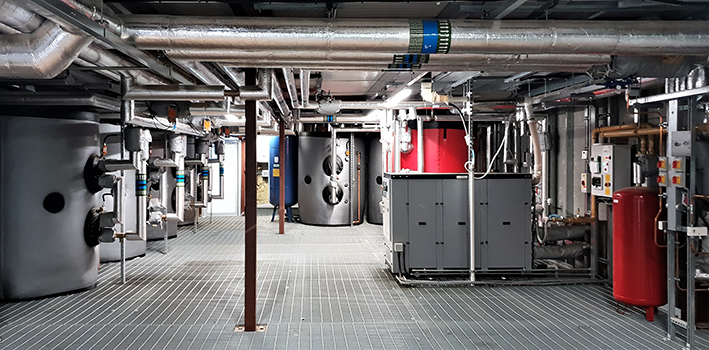 Adveco’s Technical Director, Bill Sinclair, discusses balancing concerns over the cost to health from NOx emissions with the advantages of using micro-CHP in urban commercial building projects.
Adveco’s Technical Director, Bill Sinclair, discusses balancing concerns over the cost to health from NOx emissions with the advantages of using micro-CHP in urban commercial building projects.
A by-product of the combustion of hydrocarbon fuels, Nitrogen Oxides (NOx) are a major contributing factor to poor air quality, the most toxicologically significant being a combination of nitric oxide (NO) and nitrogen dioxide (NO₂). It can cause lung irritation and respiratory infections as well as being linked to cancer, asthma, strokes, and heart disease. The Royal College of Physicians believes it directly leads to as many as 40,000 deaths each year with an estimated cost of £20 billion to the country in healthcare and lost working days. This has led to widespread recognition that more needs to be done to address NOx emissions with attention more than ever-shifting to encompass the production of emissions from the built environment.
With a greater emphasis on renewables to make our cities more self-sufficient and resilient in terms of meeting energy needs, low carbon electricity’s share of generation has currently risen to a record 50.1% across the UK with (33.4% of which is generated by renewables). But, as old power plants go offline and are replaced by unpredictable supplies like solar and wind, combined heat and power (CHP) becomes increasingly advantageous. Able to reduce a building’s reliance on the grid, yet when demand is high such as when it is cold and dark, provide a more reliable power source, CHP also has the added benefit of providing high-grade heat at lower cost in conditions where a heat pump coefficient of performance falls and the energy cost increases beyond that of gas.
Although all CHP with a catalytic converter is cleaner than the grid, localised NOx emissions from ‘dirty’ cogeneration should be a concern. Where CHP is used to offset condensing boiler run hours, if the CHP is dirtier than the condensing boiler then the local emissions are worsened. Despite air pollution and NOx mainly arising from road traffic – half of the current NOx pollution in London is attributed to vehicles – emissions from decentralised energy production are now being seen as a contributing factor. It is therefore of great importance that the NOx emissions from new CHP units within built-up areas are lower than condensing boilers if they are to have a positive effect.
Setting a new threshold for emissions
 The 2018 EcoDesign directive sets a NOx emission limit for CHP units at 240mg/kWh. This threshold, despite being approximately equal to emissions that would result from producing heat from a boiler and consuming electricity from conventional power plants, is too lenient. Air quality has been a critical driver in the revisions within the London Plan which now treats CHP with a lot less enthusiasm – although still accepting that there remains a strategic case for CHP systems as long as the NOx emissions are equivalent or lower than those of ultra-low NOx gas boilers.
The 2018 EcoDesign directive sets a NOx emission limit for CHP units at 240mg/kWh. This threshold, despite being approximately equal to emissions that would result from producing heat from a boiler and consuming electricity from conventional power plants, is too lenient. Air quality has been a critical driver in the revisions within the London Plan which now treats CHP with a lot less enthusiasm – although still accepting that there remains a strategic case for CHP systems as long as the NOx emissions are equivalent or lower than those of ultra-low NOx gas boilers.
The cogeneration industry has not been sitting on its laurels, and a new generation of ‘clean’ CHP brings all the advantages of onsite, on-demand cogeneration, and exceeds the London Plan’s expectations of ‘very low levels’ of NOx, meeting Euro 6 standards for emissions. More compact and much cleaner, micro-CHP units (in accordance with EU standards at 50kW or less rated electrical power) are available with far lower emission rates. This is the case for the TOTEM m-CHP, for example, which is independently certified at just 10mg/kWh.
If we compare a CHP meeting the 2018 EcoDesign limit of 240mg/kWh to that of a TOTEM m-CHP, we can demonstrate the real difference in the latest generation of CHP. Using a unit of 20kW electrical output, a gas input of 70kW, in a situation with an average annual run time of 6,500 hours for a standard application such as a hotel or apartment block, the yearly NOX emission from a ’dirty’ CHP will be 109.2kg/year, compared to 4.55kg/year for Adveco’s TOTEM. And remember, this option is also improving local air quality because the m-CHP is used to offset the run hours of a condensing boiler which at emissions over 30 mg/kWh is dirty compared to the CHP.
Hybrid futures
There will always be projects where in certain circumstances m-CHP will have a place and other renewables are closed out due to limitations of either the site or the technology. By the same token, we would never advocate m-CHP for every building. As is so often the case in the commercial world, each project will have its specific requirements, requiring a more bespoke approach to the provision of hot water, heating and power generation.
Increasingly we hear from consultants who are struggling to pass any kind of gas or gas CHP based heating system because of the issues around NOx emissions, despite the advantage of the high-grade heat necessary to meet the needs of commercial projects. Simply opting for heat pumps, providing a lower grade of heat, isn’t a practical alternative. One answer then is to use a combination of two or three technologies to provide a high heat, low cost, low NOx system.
This is particularly relevant to large buildings where a heat pump alone is simply not suitable. These projects need an additional, high-grade source of heat. Now, that essentially takes you to gas, but if the building is big enough, after the heat pump, but before the gas, can sit m-CHP to provide low NOx and very low running costs.
We can also make a case for using Combined Heat and Power in existing buildings which already have gas boilers and do not have the electrical supply needed to utilise a heat pump. Again, it does not make sense to fit just a heat pump. But we do not want to use CHP to offset low-temperature heat pumps, it has to sit after a heat pump, offsetting the gas heater. Such an approach will still offer some carbon savings, definitely cost savings and, if that CHP is a low NOx appliance when compared to the boiler, then we also have NOx saving. At worst such a system is going to be carbon neutral, but cost and NOx effective.
The move towards all-electric in smaller buildings also reopens the door for solar thermal with better payback case and better carbon savings. Used in conjunction with low-temperature commercial Air Source Heat Pumps (ASHPs) in an arrangement to ensure that it offsets the high-grade source, it offers an alternate hybrid approach that does not require CHP. But we believe gas-fired m-CHP will continue to play a necessary role as part of many hybrid systems, achieving effective water temperatures for commercial applications whilst balancing running costs and savings.
As with any project, design what is best for the building. We would never advocate ignoring the risk of increasing air pollution locally with “dirty” CHP systems, so if Combined Heat and Power is the best fit for your project’s needs then it is vital to choose the lowest NOx emitting equipment available. Right now, the Mayor of London is supporting the city’s Cleaner Heat Cashback scheme for SMEs, proposing scrapping of old gas boilers and replacing them with a variety of options including new efficient gas boilers. If we can demonstrate that m-CHP, either standalone or in a hybrid system, can offset condensing boiler run hours and make emissions cleaner then there is surely a place for the technology, even in the centre of our busiest cities.
 Discuss your next project with Adveco whether it’s a hydrogen-ready CHP or commercial Air Source Heat Pumps (ASHP).
Discuss your next project with Adveco whether it’s a hydrogen-ready CHP or commercial Air Source Heat Pumps (ASHP).
Call Adveco today on 01252 551 540













